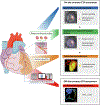The evolving role of coronary computed tomography in understanding sex differences in coronary atherosclerosis
- PMID: 34654676
- PMCID: PMC9358989
- DOI: 10.1016/j.jcct.2021.09.004
The evolving role of coronary computed tomography in understanding sex differences in coronary atherosclerosis
Abstract
Our understanding of sex differences in subclinical atherosclerosis and plaque composition and characteristics have greatly improved with the use of coronary computed tomography (CCTA) over the past years. CCTA has emerged as an important frontline diagnostic test for women, especially as we continue to understand the impact of non-obstructive atherosclerosis as well as diffuse, high risk plaque as precursors of acute cardiac events in women. Based on its ability to identify complex plaque morphology such as low attenuation plaque, high risk non calcified plaque, positive remodeling, fibrous cap, CCTA can be used to assess plaque characteristics. CCTA can avoid false positive of other imaging studies, if included earlier in assessment of ischemic symptoms. In the contemporary clinical setting, CCTA will prove useful in further understanding and managing cardiovascular disease in women and those without traditional obstructive coronary disease.
Keywords: And cardiac computed tomography; Atherosclerosis; Cardiovascular disease; Ischemic heart disease; Sex; Sex disparities; Women.
Copyright © 2021 Society of Cardiovascular Computed Tomography. Published by Elsevier Inc. All rights reserved.
Figures



References
-
- Cushman M, Shay CM, Howard VJ, et al. Ten-year differences in women’s awareness related to coronary heart disease: results of the 2019 American heart association national survey: a special report from the American heart association. Circulation. 2021;143(7). 10.1161/CIR.0000000000000907. - DOI - PMC - PubMed
Publication types
MeSH terms
Grants and funding
LinkOut - more resources
Full Text Sources
Medical
Miscellaneous

